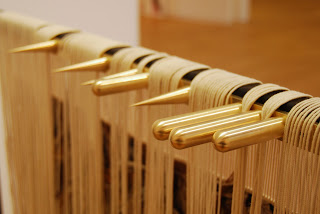The concept of 'categorising' tapestry has always been one of difficulty. Is it a craft? A textile? A work of fine art? What about the elements of design? Or the difference between a tapestry designed by a weaver, or one designed by a so-called fine artist?
One thing which I have been considering if the profound difference between woven tapestry and other woven textiles (for the purpose of this blog I'll be referring to them as cloth). The differences are not just concerned with weaving methods, but also design and function.
Weaving Method
 |
| David Cochrane weaving a sample for a project with Claire Barclay at Dovecot, 2010 |
Both tapestry and cloth are woven using warp and weft. The warps are prepared on the loom, parallel to each other, and the weft is woven through them. This is where the similarities end. During the weaving of cloth, both the warp and weft remain visible and the weft is woven through the warp from one side to the other. In tapestry weaving, the weft covers the warp (exceptions to this rule occur in some experimental tapestries) and is not seen in the finished piece. In addition, the weft is not woven from one side of the tapestry to the others - instead a number of bobbins (as seen in the image above) are used in sections of the tapestry, both small and large, to create areas of different colours.
Design
The design process for tapestry and cloth is different in many ways. The patterns or colours in cloth can either be incorporated during the weaving process or printed onto the fabric afterwards. Because of the industrial production of some cloths, patterns are often repeatable, such as the one below:
 |
| Harold Cohen for Heal and Son Ltd, Vineyard, c.1959, screen printed cotton, 48in, repeat 21 5in |
Tapestries are more finite and this has an impact on the design process. The weaving of repeated patterns in tapestry is not time-saving - the tapestry will take just as long to weave if the design is one large image or a small image repeated 10 times. Becuase of this, designs for tapestries are conceived as you might a painting. The design is held by the four sides of the tapestry and the complexities of repeating patterns need not be a concern.
 |
| Verdure, designed by Liz Rideal, woven at Dovecot Studios |
Function
Cloth today is both utilitarian and artistic. It is industrially woven in enormous amounts for clothing and upholstery. But there are also a number of individual weavers who create beautiful weavings which cannot be seen as anything other than works of art.
 |
| Laura Thomas, Grasses, jacquard woven silk and cotton, 60x70cm, 2007 |
Throughout history tapestry has been utilised for its acoustic and thermal abilities. Often woven in wool, cotton or silk, tapestries were used to warm drafty stone castles in Medieval France. Today, large tapestries are still commissioned to act as an acoustic tool hidden in a work of art. But the primary function of tapestry today is one of aesthetic. People purchase them to hang in their homes, or corporate buildings for the same reason they purchase any other work of art: to enjoy looking at it.
 |
| St Catherine's Triptych, designed by Tom Phillips, woven at Dovecot Studios, St. Catherine's College, Oxford |
It is clear that the term 'textile' encompasses a wide variety or practices and creative methods. This should be celebrated. Textiles have one of the richest histories out of all of the arts - and their development from their use as shelters from the elements to items worthy of display in a gallery makes a fascinating story.








